Electrifying Everything: No sun, no wind, no problem
The final piece of the renewable generation puzzle lies in geothermal, hydro and nuclear power.
The post below, released today, was written by Energize investors Tyler Lancaster and Mark Tomasovic. We are believers in the “electrification of everything movement” but far from ideological in our support of wind/solar/batteries. The fact is that the energy transition needs a menu of power sources to deliver quality, cleanliness and volume. The post below reveals how we think about geothermal, nuclear, and hydro power. Link found here as well.
By: Tyler Lancaster, Principal at Energize Ventures & Mark Tomasovic, Associate at Energize Ventures
Electrification is a key theme to Energize’s investment thesis. We invest in software and business model innovation, many of which directly contribute solutions towards decarbonization by means of electrification. In this blog series, we’ll explore this critical transition and the technologies driving and enabling it.
Solar, wind and storage: A killer combo, not a panacea
Solar, wind and storage are a killer combo. Together, they can decarbonize at least 80 percent of electricity supply in the U.S. Leading experts agree that “rapid cost declines for wind, solar, and battery storage have enabled a transition towards 80 to 100 percent clean electricity in the 2030 to 2035 timeline at a modest cost to electricity customers,” per a meta-study conducted by Energy Innovation: Policy & Technology LLC.
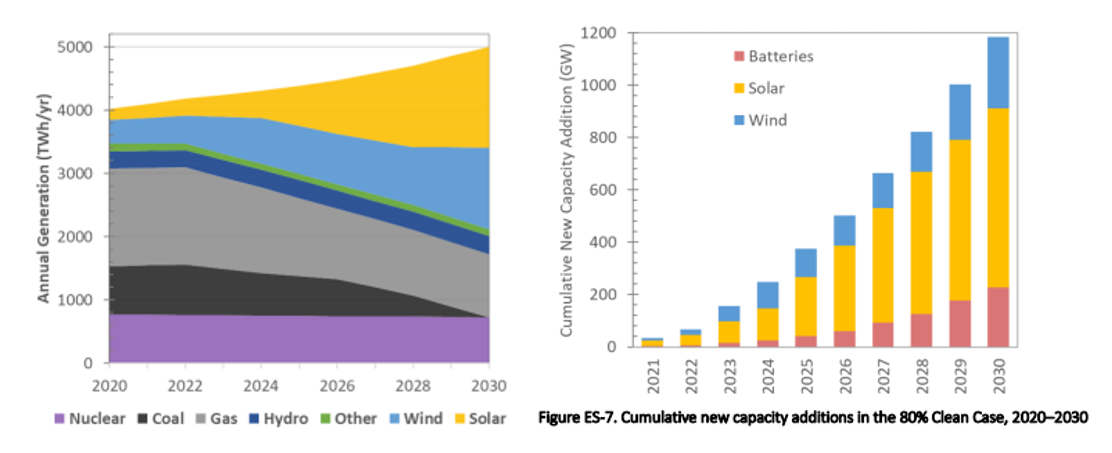
To transition the remaining 20 percent of electricity to zero carbon, we’ll need a combination of technologies that also can provide non-intermittent, dispatchable electricity. Nuclear, hydropower, geothermal, biomass or biofuels, or natural gas plans paired with in-situ carbon capture and sequestration (CCS) are prime candidates.
Where to find “zero-carbon, dispatchable, high-capacity factor” power?
We believe the first of these three — nuclear, hydropower and geothermal — will play the most important roles in complementing solar, wind and batteries over the next 10 to 20 years. These technologies display the necessary combination of input resource abundance (uranium, water, and the Earth’s heat, respectively), technology maturity and compelling economics.
Nuclear: Keep the plants running
When it comes to nuclear power generation, simply keeping existing plants open is the key. Today, 20 percent of power generation in the U.S. comes from nuclear. Solar and wind are not yet able to fully replace the energy provided by nuclear plants that are turned off. Unfortunately, most existing nuclear plants are increasingly uneconomic as levelized costs have ballooned by 23% in the past decade. However, turning them off can be massively costly for the climate.
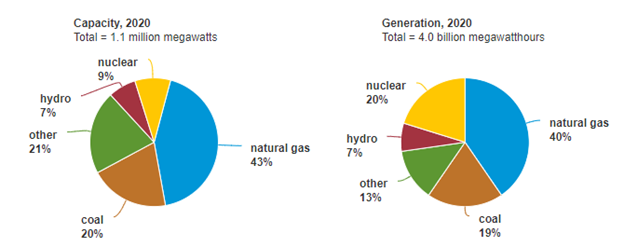

Because it is so difficult and expensive to build new nuclear plants, we have essentially stopped building new nuclear in the U.S. for commercial operation. Novel nuclear technologies such as small modular reactors and fusion hold immense promise, yet are unlikely to be technologically de-risked, commercially available, or cost-effective in the next decade. When they are, they can join the decarbonization party. In the meantime, we should keep existing nuclear plants running even if subsidies are required. The alternative usually means higher emissions in the short-run, as we’ve seen in New York with the closure of the Indian Point nuclear facility.https://cdn.embedly.com/widgets/media.html?type=text%2Fhtml&key=a19fcc184b9711e1b4764040d3dc5c07&schema=twitter&url=https%3A//twitter.com/drchrisclack/status/1416180201424293893&image=https%3A//i.embed.ly/1/image%3Furl%3Dhttps%253A%252F%252Fabs.twimg.com%252Ferrors%252Flogo46x38.png%26key%3Da19fcc184b9711e1b4764040d3dc5c07
While keeping nuclear plants online is important, hydropower and geothermal are poised to play the largest role in filling out the remaining 20 percent in the more immediate future. Both rely on renewable resources — water and heat — that we already know how to use in electricity generation. The technology risk is therefore low, and simultaneously costs are dropping thanks to new technology-enabled approaches to increase efficiency, such as data analytics and edge computing.
Hydropower: Reinvigorating the original turbine technology
Today, hydropower generates about 16% of the world’s electricity usage, according to National Geographic. The energy source is clean, easy to ramp up or down to match electricity demand, and constantly renewed by snow or rainfall.
While there are a few types of hydropower, the most common type is called an impoundment hydroelectric plant. Impoundment plants consist of three parts: a reservoir of water, a dam to channel the water, and a turbine generator. Water from the reservoir is released through the dam to generate power and meet electricity needs (via Energy.gov). In fact, impoundment plants are incredibly efficient: modern hydro-turbines can convert as much as 90 percent of available energy into electricity. This is on-par with capacity factors for nuclear power, and twice that of typical gas and coal plants. Additionally, the life cycle of a hydro plant produces very little carbon emissions (USBR.gov).
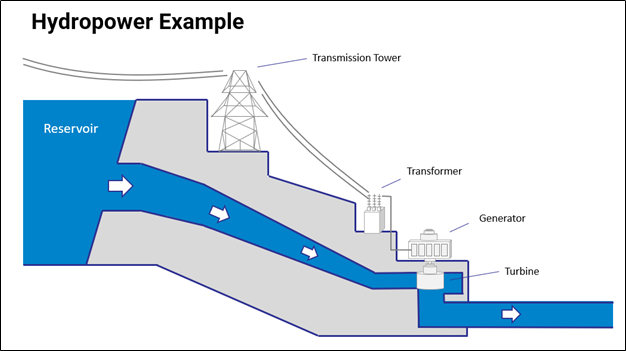
However, there are still a few challenges associated with operating hydropower facilities. Just as generation of solar and wind energy is dependent on environmental conditions, hydroelectric potential relies on an adequate water level in the reservoir, which can fluctuate monthly depending on precipitation. For example, climate change is depleting water resources via decreased snowmelt in areas like California, thereby reducing hydropower output when it is needed most during high periods of energy demand in the summer.
Like other critical infrastructure, maintaining and monitoring asset performance is key to operating hydropower facilities. Digital sensors connected to edge analytics platforms like ZEDEDA (an Energize portfolio company) can create feedback loops for predictive maintenance on turbine equipment. Companies like Natel Energy are even developing their own connected, fish-safe turbine generators that can operate in shallow rivers and communicate together to provide distributed baseload energy.
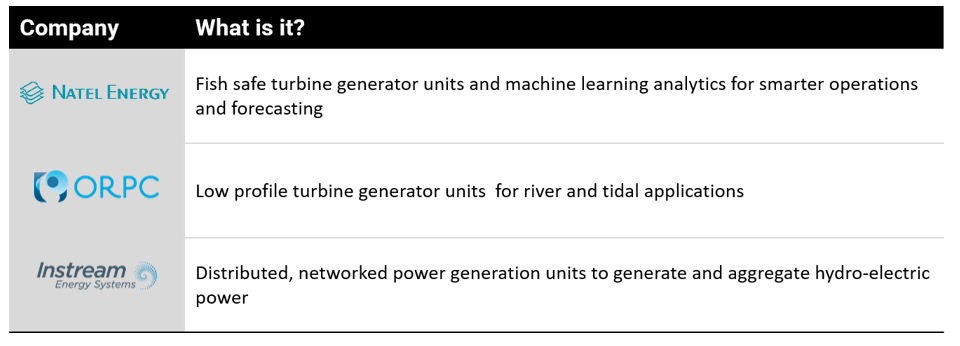
Hydropower is already one of the largest renewable resources in the world, producing more than 4,300 TWh of energy globally, and new technologies are enabling hydroelectric plants to improve system reliability and safely access new resources. Hydropower will continue to play a significant role in the energy landscape, providing a clean and increasingly reliable source of flexible electricity for decades to come.
Geothermal: An underdeveloped renewable resource
The inside of the earth is hot. Deep within the mantle of our planet, radioactive elements are constantly decaying, generating over 30 TW of energy (An Introduction to Nuclear Waste Immobilisation). In fact, the earth produces so much energy that if we were capture all of its heat, we could power more than 20 billion homes every year. Geothermal energy is clean, green and reliable. So, the only question now is — how do we make it affordable?
Geothermal projects must balance cost with resource quality. Drilling deeper to access better, hotter resources often increases the overall cost of the project. The goal is to find a hot enough resource close enough to the surface so that the project economics make sense. Using existing technologies, the U.S. has been able to find and develop about 3 GW of near-surface geothermal power. However, now that the obvious resources have been tapped, we need to improve prospecting capabilities to scan the earth for less obvious reservoirs. Companies like Zanskar are building data-driven software platforms to de-risk this geothermal exploration process.
Geothermal companies like Fervo Energy are using innovative drilling and completion methods to maximize the heat captured from the earth. For every mile we drill down beneath our feet, the temperature increases by about 75 degrees Fahrenheit. Using the earth as a heat exchanger, these companies inject cold water into wells thousands of feet deep. The water is warmed by the heat of the earth, and then exits through a production well where it can be used to generate power. These projects must precisely design the right size and depth of these systems to produce substantial energy while managing the overall cost of the facility.
“Fervo Energy incorporates proven technologies, like horizontal drilling and advanced distributed fiber optic sensing, into a novel geothermal system that delivers more predictability and lower costs than previously possible,” said Tim Latimer, CEO of Fervo. “This opens up new areas for geothermal development, right at the time when customers are demanding more 24/7 clean power. Geothermal has a key role to play in a fully decarbonized electric system, and recent technology breakthroughs will make that a reality.”
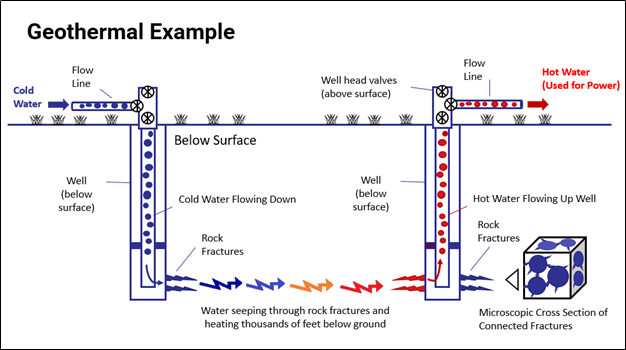
Finally, beyond using geothermal to generate power at a central plant, you may be able to offset some of your electricity usage by installing a geothermal system in your own backyard. Whether it’s summer or winter, the earth maintains a relatively constant temperature at a few hundred feet deep. New companies like Dandelion Energy have capitalized on this consistency by building ground loops to heat (or even cool) residential homes.
Geothermal is at a turning point. As with other renewable energy sources, regulators are now driving adoption of geothermal energy. The California Public Utilities Commission approved its plan to install 1,000 MW of geothermal energy by 2026. At the same time, new technologies are entering the market that support scalability — helping to decrease the cost of capital for geothermal projects and attract new capital to meet net-zero goals.
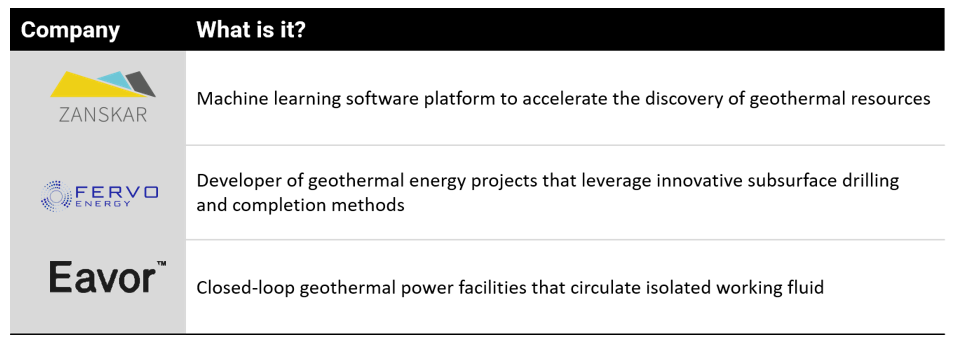
From energy generation to transmission and distribution
Solar and wind energy paired with battery storage are dominating the grid at an accelerating pace. If the renewable energy transition were a Broadway show, these three would be the rising stars. But we can’t get to 100 percent no-carbon electricity generation without several important supporting roles. Non-intermittent, flexible baseload power like nuclear, hydro and geothermal will be essential in keeping the lights on when the wind doesn’t blow and the sun doesn’t shine. We believe these secondary renewable energy sources are here to stay, and venture-backable technologies that can increase efficiency, lower costs and support scalability have the potential to capture outsized market share.
As I’ve iterated on before, decarbonizing by electrifying everything reduced to its simplest form depends on four key tenets:

I have covered the first bucket across solar, wind, batteries, geothermal and hydro. I argue these technologies are most critical to decarbonizing electricity generation over the next 10 to 20 years. Enabling digital solutions and software are playing a key role in reducing “soft costs,” accelerating deployment, and engineering new form factors of no-carbon electricity.
Casting forward, if we can “make” massive amounts of zero-emission, renewable electricity, then we’ll need a way to “move” it from oftentimes rural locations to the places it will be used — our homes and businesses.

In my next piece, I’ll cover the imperative to invest in electricity transmission and distribution. Digital technologies and software are playing an essential role in getting the most out of our existing T&D infrastructure. More to come!